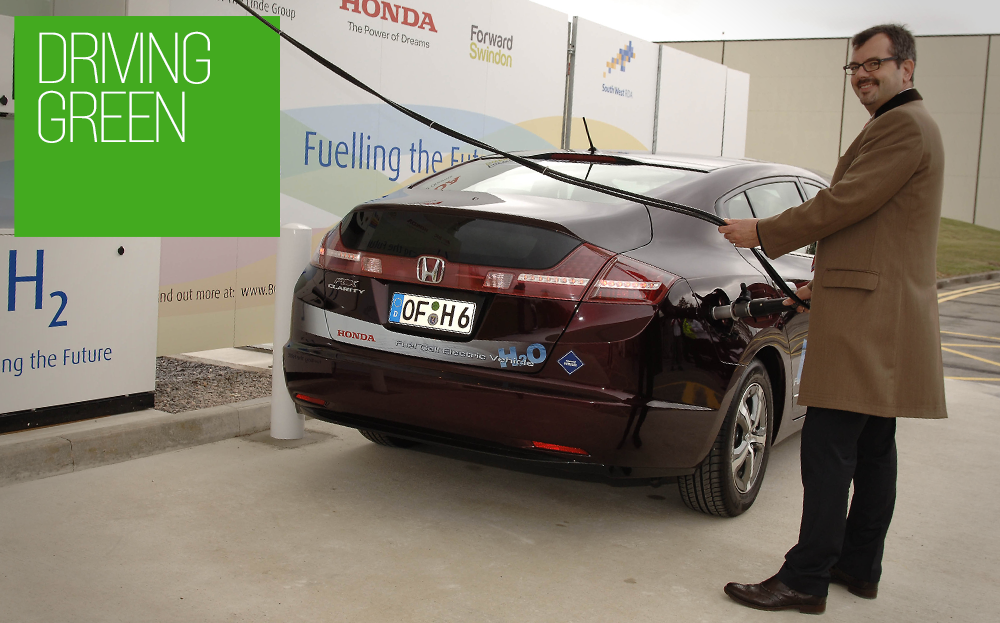Driving Green: What are hydrogen fuel cell vehicles?
A lot of hot air?

HYDROGEN is the most abundant element in the universe, and when it’s burned in air the only by-product is water vapour. So wouldn’t it be great if hydrogen could be used to power cars? Well, it can. To a point. But of course there are lots of catches.
Shop for a green car now
Hybrid | Plug-in Hybrid | Pure-electric
Firstly, much of that hydrogen is joined at the hip with oxygen in the form of water, which has to be electrolysed to get the hydrogen out. Which means putting in lots of energy to get (potentially less) energy out*. Then the highly flammable gas has to be stored, and perhaps transported in trucks to filling stations (sound familiar?). Suddenly, hydrogen doesn’t appear to be such a wonder fuel after all.
But this hasn’t stopped many car makers working on hydrogen fuel cell vehicles (FCVs) for decades, and it’s around now that we’re starting to see their hard work reach fruition. Hyundai has already put a fuel cell ix35 on sale in the UK while Toyota is about to bring a handful of hydrogen-powered Mirais here for selected customers to try them out. Honda though, has been working on FCX prototypes since 1999, and its latest evolution, the FCX Clarity, has been notching up test miles in the US since 2008.
While Toyota hasn’t released a purchase price for its Mirai, the Hyundai is pitched at £53,105 – and that’s after a £15,000 subsidy from the European HyFive consortium. Bearing in mind the most expensive regular ix35 costs little more than half this, purchase prices are pretty unpalatable at the moment. After all, what do you get for all that money?
In simple terms, you get a car that’s much like an electric vehicle to drive, but it can be refuelled in minutes rather than hours.
Under the skin there’s plenty going on. An FCV is powered by hydrogen which isn’t burned – instead it reacts with oxygen from the atmosphere in a fuel cell to create electricity, which is used to power electric motors to drive a car’s wheels. The only by-product from the tailpipe is water that’s (technically) pure enough to drink.
Aside from the high purchase prices at present, running a fuel cell car isn’t easy because there’s currently virtually nowhere to refuel. There are just three public stations in the UK and eight others in private/corporate hands. Buyers don’t want to spend lots of money on a car they can’t refuel, while car makers don’t want to make products that nobody will buy.
Meanwhile the fuel companies don’t want to build infrastructure that nobody will use, so until there’s a level of critical mass in terms of infrastructure, fuel cells are likely to remain a very rare sight on British roads.
For more on hydrogen fuel cells, check out the UK Hydrogen and Fuel Cell Association website.
* This energy could come from renewable sources, of course, which would make it a very clean fuel but it begs the question: why not use that electricity to charge up a battery?
Driving Green contents
Introduction to green driving
- What is a “green” car?
- What does Euro 6 mean when it comes to emissions?
- Why have green cars been developed?
- Nine tips for eco-driving
Choosing a green car
- What are hybrid cars?
- What are plug-in hybrid (PHEV) cars?
- What are extended-range electric vehicles (E-REVs)?
- What are hydrogen fuel cell vehicles?
- Are pure-electric cars suitable?
- Whatever happened to LPG (liquid petroleum gas)?
- What are biofuels?
Green car buying guides
Financial, environmental and practical implications of green motoring
- Electric car UK public charging point maps
- The truth about real-world mpg and fuel costs
- How much is VED (road tax) for green cars?
- Are electric cars expensive to insure?
Click to read car REVIEWS or search NEW or USED cars for sale on driving.co.uk




